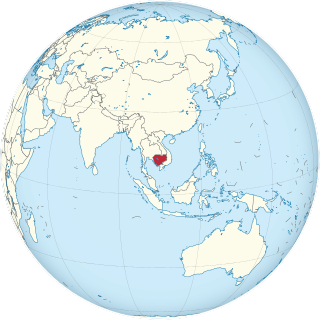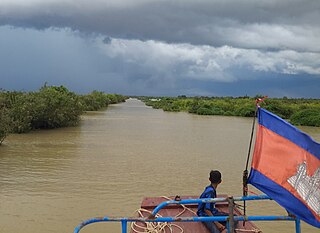
Cambodia is a country in mainland Southeast Asia. It borders Thailand, Laos, Vietnam, the Gulf of Thailand and covers a total area of approximately 181,035 km2 (69,898 sq mi). The country is situated in its entirety inside the tropical Indomalayan realm and the Indochina Time zone (ICT).

Tonlé Sap (; Khmer: ទន្លេសាប, Tônlé Sab ; lit. 'Fresh River' or commonly translated as 'Great Lake' is a lake in the northwest of Cambodia. Belonging to the Mekong River system, Tonlé Sap is the largest freshwater lake in Southeast Asia and one of the most diverse and productive ecosystems in the world. It has been designated as a Biosphere Reserve by UNESCO in 1997 due to its high biodiversity. In the 21st century, the lake and its surrounding ecosystems are under increasing pressure from deforestation, infrastructure development and climate change.
Aglaia leptantha is a species of tree in the family Meliaceae. It is found in Mainland and Island Southeast Asia. People use the plant for food, incense, and for human and bovine medicine. Gibbons also eat parts of the tree.

Campylospermum serratum is a plant in the family Ochnaceae. The specific epithet serratum is from the Latin meaning "with teeth", referring to the leaf margin. It is found in Tropical Asia, from Sulawesi, Indonesia to Hainan, Zhōngguó/China and over to southwester India. Gomphia serrata was a previous common name for the species. The plant is used for it wood and its sap is used in folk medicine and in the past for teeth-blackening.
Natural resources are materials that occur in a natural form within environments. These can be classified as either biotic or abiotic on the basis of their origin. The landmass and the territorial waters of Cambodia contain a rather moderate amount, array and variety of resources. Apart from water, abiotic resources, such as minerals are generally rare. Still, advanced geo-scientific technologies have produced remarkable results and re-assessments in recent years, such as the localization of offshore oil and gas depots in the Gulf of Thailand. Cambodia, on the other hand possesses a relatively wide range of biotic resources, in particular timber, forest products, rare plants and a fauna of great diversity.
Boeng Tonle Chhmar is a 145.6 km2 (56.2 sq mi) large multiple use management area in Cambodia bordering Tonlé Sap lake that was established in 1999. It is located in Peam Bang Commune in Kampong Thom Province.
Diospyros venosa is a tree in the family Ebenaceae. It is native to Southeast Asia, from the Maluku Islands to Myanmar. It provides raw material for handicrafts, traditional medicine and fuel.
Homalium brevidens is a shrub or tree species in the family Salicaceae, found in Laos and Cambodia.
Hydnocarpus saigonensis is a tree in the Achariaceae family. It is endemic to the Mekong basin of Cambodia and southern Vietnam.
Terminalia cambodiana is a species of tree in the family Combretaceae, growing some 6–15 m tall with whitish-grey, exfoliating bark and large greenish branches. It is found in flooded forest communities of Cambodia and southern Vietnam.
Senegalia thailandica is a species of climbing or sprawling shrub in the family Fabaceae.

The Tonle Sap freshwater swamp forests ecoregion covers the seasonally flooded forests surrounding Tonlé Sap, the largest lake in Cambodia, and the floodplains of its connections to the Mekong River. Over 35% of the ecoregion experiences flooding during the wet season.

The Tonle Sap-Mekong peat swamp forests ecoregion covers a patchwork of areas permanently inundated with fresh water along the Tonle Sap River and Mekong River floodplains in Cambodia and Vietnam. The terrain is mostly flat, with extensive agricultural fields, reed beds, and degraded shrub forest. Less than 10% of the region is in its original state, and less than 1% is protected. Habitat in the region is distinguished from the Tonle Sap freshwater swamp forests ecoregion that runs through the middle, as that ecoregion is only seasonally flooded.

Elaeocarpus griffithii is a tree in the family Elaeocarpaceae. It is found in parts of Island and Mainland Southeast Asia. It is used in construction, as firewood and in dyeing.
Gluta cambodiana is a shrub/small tree in the family Anacardiaceae. It occurs in parts of Mainland Southeast Asia. Its wood is used for pickets and fuel.
Combretum trifoliatum is a vine of the family Combretaceae. It is found from Myanmar across Southeast Asia and Wallacea to New Guinea and Australia. It grows in wet places, including where it can be submerged for four months a year by floodwaters. It is unusual in retaining its photosynthesizing leaves when flooded. Parts of the plant are used in traditional medicine.
Samadera harmandiana is a freshwater mangrove shrub or small tree in the Simaroubaceae family. It is found in Cambodia, Laos and Vietnam. The wood provides firewood. Certain fish eat the poisonous fruit

Xanthophyllum lanceatum is a tree in the Polygalaceae family. It grows across Southeast Asia from Sumatera to Bangladesh. The leaves are used as a hops-substitute in beer making and the wood as fuel. Fish in the Mekong regularly eat the fruit, flowers and leaves.
Liquidambar cambodiana, commonly known as sdey, is a tree in the Altingiaceae family endemic to south west Cambodia.

Aniseia martinicensis is a species of herb climber in the Convolvulaceae family. Native to subtropical and tropical America, it has been introduced to the tropics and sub-tropics of the Pacific Islands, Australia, Asia, and Africa. It is usually eaten as a supplementary vegetable. Even though it grows around the world, in a variety of habitats, it is a rare plant.







